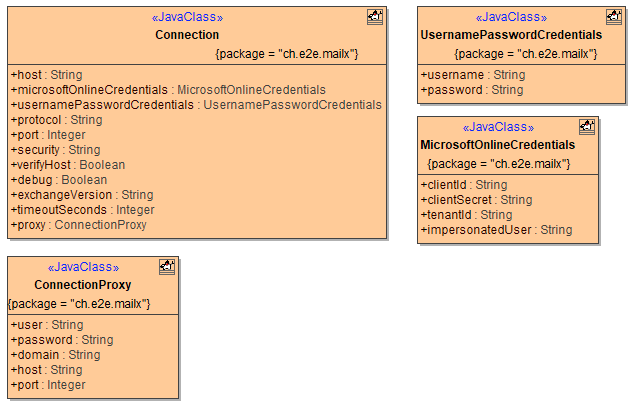An instance of Connection is the first parameter of all MailClient operations. On first encounter in a call, the library will initiate the connection and retain it, i.e. successive calls using the same connection settings will re-use the already opened connection to the mail server, where "same" is identified by host+user+protocol+port+security. So changes to any of these attributes will be considered being a "new" connection, while changes on any other attributes have no effect.

Attributes keystore and keystorePassword that you may miss if you are migrating from version 1, have been removed from the Connection object. Loading the keystore is now a global operation on the Crypto class, see Keys and Certificates.
Connection
Class Connection has the following attributes:
Attribute NameTypeDescriptionAllowed ValuesdebugBooleanSpecify whether to write additional debug information to the bridgeserver log.trueAdditional debug information is written to the bridgeserver log.falseNo additional logs (default).exchangeVersionStringSpecify the Microsoft Exchange version (optional).2007_SP1 Exchange 2007 Service Pack 12010Exchange 20102010_SP1Exchange 2010 Service Pack 12010_SP2Exchange 2010 Service Pack 2 and higher (default)hostStringSpecify the host name/IP address of the mail server.a valid host name or IP addressfor exchange connections this can be left NULL, triggering Autodiscover (which might fail)for office365 connections this is ignoredmicrosoftOnlineCredentialsObjectSpecify OAuth login credentials for Microsoft Online connectionsa valid set of credentialseither this or usernamePasswordCredentials must be setportIntegerSpecify the port of the mail server (optional)a valid port numberIf omitted (NULL), the standard port for the chosen protocol and security is used.protocolStringSpecify the protocol used for e-mail retrieval and storage.Values are not case sensitive.imapUse the IMAP protocol.imapsUse IMAP over SSL.pop3Use POP3.smtpUse the SMTP protocol.smtpsUse the SMTPS protocol.exchangeUse Exchange Web Service (EWS) API with a hosted Exchange Serveroffice365Use Exchange Web Service (EWS) API with a Office 365 Server (will ignore host).securityStringSpecify the encryption.Values are not case sensitive. exchange and office365 protocols ignore this setting and use ssl anyway.noneNo encryption used.exchange and office365 protocol (see attribute protocol) use SSL in any case, this cannot be overridden.sslUse SSL encryption. starttlsUse TLS encryption.exchange and office365 protocol (see attribute protocol) use SSL in any case, this cannot be overridden.Make sure to pick imap, pop3, or smtp with this setting, not imaps, pop3s, or smtps.timeoutSecondsIntegerSpecify the number of seconds after which a request (send or receive) times out.any positive integerDefault is 0, which translates to the following defaults:infinite timeout for imap(s), pop3(s), and smtp(s)100 seconds for exchangeusernamePasswordCredentialsObjectSpecify the user's credentialsa valid set of credentialseither this or microsoftOnlineCredentials must be setverifyHostBooleanSpecify whether for SSL connections the mail server host shall be verified or not (optional).trueVerify the mail server's SSL certificate (default, see also security).falseDo not verify the mail server.Username and Password Credentials usernamePasswordCredentials.usernameStringSpecify the user account on the mail server.a valid user name Some SMTP servers allow unauthorized sending, in these cases you may leave it as NULL.usernamePasswordCredentials.passwordStringSpecify the user's password.a valid password Some SMTP servers allow unauthorized sending, in these cases you may leave it as NULL.Microsoft Online Credentials (only applicable to office365 protocol) microsoftOnlineCredentials.clientIdStringclient id of your app registration For details on registering EWS access via OAuth please follow the steps as outlined here: https://docs.microsoft.com/en-us/exchange/client-developer/exchange-web-services/how-to-authenticate-an-ews-application-by-using-oauthMake sure to follow the path for "app-only authentication"microsoftOnlineCredentials.clientSecretStringclient secret of your app registrationmicrosoftOnlineCredentials.tenantIdStringtenant id of your microsoft online organizationmicrosoftOnlineCredentials.impersonatedUserStringname (email address) of the mailbox you want to impersonatea valid email address Provide the email address of the mailbox you want to interact with (e.g. read messages from)Proxy Settings (only applicable to HTTP based connections, i.e. exchange or office365 protocol)proxy.hostStringSpecify the host name/IP address of the proxy server.a valid host name or IP addressproxy.portIntegerSpecify the port of the proxy server.a valid port numberproxy.domainStringSpecify the user domain on the proxy server (optional). Some Windows-based proxy servers might require this for authentication.a valid ActiveDirectory domain nameproxy.userStringSpecify the user account on the proxy server (optional).a valid userproxy.passwordStringSpecify the user's password (optional).a valid password
